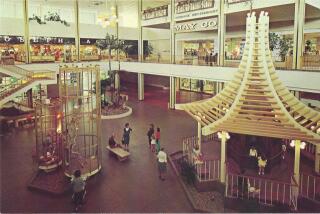Builder Who Lost Pomona Mall Deal Sues : Development: The man who built Phillips Ranch claims that Pomona illegally thwarted his bid to put together a regional shopping center. City officials deny the charges.
- Share via
POMONA — Two corporate dropouts from Pomona’s troubled mall project cost the city time and aggravation, but local developer Alvin Lesser says they cost him something too: $1 million.
Lesser, developer of Pomona’s upscale Phillips Ranch subdivision, and his company, Sonmik Inc., have filed a breach-of-contract suit against the city Redevelopment Agency, claiming they were illegally cut out of a deal to develop the proposed regional shopping center on 74 acres purchased by the agency for nearly $11.3 million in 1982.
Lesser said he was promised $1 million for putting together deals to build the mall with companies affiliated with The Broadway and May Co.--both of which ultimately dropped out of the project.
In the suit filed in Pomona Superior Court three weeks ago, Lesser claimed he would have been entitled to a 5% interest in the mall if Carter Hawley Properties Inc., an affiliate of The Broadway, had followed through with plans to build the shopping center. But Carter Hawley Properties abandoned the project in 1986 after four years of work because of a corporate retrenchment in shopping center construction.
Then, when May Centers Inc. took over the project, the suit said, the Redevelopment Agency agreed to pay Lesser’s company $1 million if May Centers or any other developer recruited by Lesser built the mall. The first payment of $500,000 would have been due when May Centers signed a binding obligation to build the mall, but the project never advanced that far.
Officials with May Centers have said they lost interest in the project at least partly because of the discovery of contaminated soil on the site. City officials say the contamination, which includes glass and metals, is a manageable problem limited to three acres.
When May Centers abandoned the project, Lesser alleged, he was denied an opportunity to find another developer. Instead, he said, the City Council handed the project to Forest City Development, a national builder of shopping centers, apartments and office towers.
The suit, which seeks $1 million from the Redevelopment Agency, claimed that May Centers would have built the mall if its negotiations with the city had not been disrupted by political upheaval in Pomona, including the ousters and resignations of 20 department heads and city administrators since 1987.
City Atty. Arnold Glasman said there is no evidence that political turmoil cost Pomona a shopping center. He said that charge “is easy to allege, but difficult to prove. We don’t feel that the lawsuit has any merit whatsoever.”
Glasman said Lesser had ample time after May Centers pulled out of the project to recruit other developers. The city’s preliminary agreement with May Centers expired in mid-1989, and the city gave an exclusive development agreement to Forest City in October, 1990.
The proposed regional shopping center, to be built at the junction of the Pomona Freeway and Corona Expressway, was part of the Phillips Ranch master plan developed by Lesser. More than 4,000 houses and condominiums were built in Phillips Ranch in the 1970s and 1980s.
In the suit, Lesser says he is “ready, willing and able” to seek other developers for the site, but has been excluded from the project.
City Administrator Julio Fuentes declined to comment on the lawsuit, but said Forest City Development is making progress in lining up tenants for the proposed mall. He said Forest City has obtained letters of interest from two department stores and is seeking a third tenant to anchor the mall.
Pomona is competing for tenants with two other proposed malls. May Centers is working on a mall project in Chino Hills, and Homart Development Co., which is affiliated with Sears, is spearheading efforts to build a mall in Chino. Developers and city officials say all the proposed malls would serve the same market, and only one is likely to be built.
More to Read
Sign up for Essential California
The most important California stories and recommendations in your inbox every morning.
You may occasionally receive promotional content from the Los Angeles Times.






